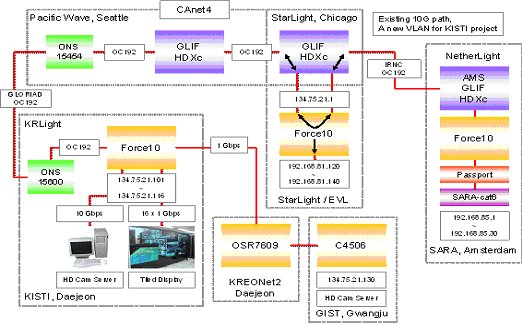GOLEs core to visualisation demonstration
17 March 2006 -- The GLIF Open Lightpath Exchanges (GOLEs) KRLight, Pacific Northwest Gigapop, StarLight, and NetherLight jointly participated in building global-scale 10 Gbps lightpaths to support large data transfer on the GLVF (Global Lambda Visualization Facility) for the advanced research institutions in Korea, the US, and the Netherlands. The OptIPuter node in KISTI (Korea Institute of Science and Technology Information) received several HD animations generated by supercomputers from EVL (Electronic Visualization Laboratory, US) and SARA (the Netherlands), and along with live uncompressed HD streaming from GIST (Gwangju Institute of Science and Technology, Korea), total bandwidth usage reached over 3 Gbps. The live feeds of the HD animations were able to be provided at high-quality across the lightpath supported by GLORIAD and NSF/IRNC whilst the GLVF demonstration was being performed in Korea to show global scale e-Science initiatives to the government officials of MOST (Ministry of Science and Technology) of Korea.
In order to achieve point-to-multipoint lightpath provisioning between participants in three different continents, four GOLEs operated by KISTI, CANARIE, UIC/ANL, and SURFnet, provided their lambda networking resources based on SONET/SDH OXCs and 10GE switches. Their joint operations required seamless composition of Trans-Pacific, Trans-American, and Trans-Atlantic lambdas, and reflected the importance of GLIF coordination efforts to-date.
The network configuration of the lightpaths is shown in the diagram below. A 10 Gbps lightpath was provisioned over the Trans-Pacific GLORIAD-KR OC-192 circuit from KRLight in Daejeon, Korea, to the CANARIE GLIF node in Seattle, US, which utilise Cisco ONS15600 and ONS15454 equipment respectively. The lightpath connects to StarLight Force10 E1200 through the two Nortel HDXc optical cross connects in the GLIF nodes in Seattle and Chicago, provided by CANARIE. Another lightpath, on a Trans-Atlantic lambda, was extended from NetherLight in Amsterdam, the Netherlands, to StarLight over the IRNC OC-192 connection, using the NetherLight HDXc. For local connections, 10 GE or multiple 1 GE connections were established between the GOLEs and end-systems at each institution. Eventually, the StarLight E1200 acted as a one-hop gateway for all the participants, KISTI (Korea), EVL (US), and SARA (Netherlands), switching those end-users in a centralized fashion.

For the demonstration, a 10 megapixel, SAGE-enabled tiled display was used as an output device. Five or six HD streams from each institution were displayed on the tiled xscreen at the same time during the event. From EVL, an HD animation of a Katrina flooding model, and an uncompressed SVC HD stream were sent to KISTI. In addition, a pre-rendered animation of Visible Korean Human data was played from EVLís cluster. An animation of a tornado simulation, created by NCSA, was streamed from SARA, whilst GIST and KISTI sent an SVC HD stream to the tiled display.
About GLIF -- The Global Lambda Integrated Facility (GLIF) is a international cooperative initiative to establish and coordinate a global-scale optical network to support scientific research. The GLIF network is based around a number of lambas (dedicated high-capacity circuits based on optical wavelengths), contributed by the GLIF participants who own or lease them, and interconnected through a series of exchange points. These exchange points, known as GLIF Open Lightpath Exchanges or GOLEs, are usually also operated by GLIF participants, and are comprised of equipment that is capable of terminating transparent lambdas and performing lightpath switching. This way, different lambdas can be connected together, and end-to-end lightpaths established over them. More information is available on the GLIF website at http://www.glif.is/

